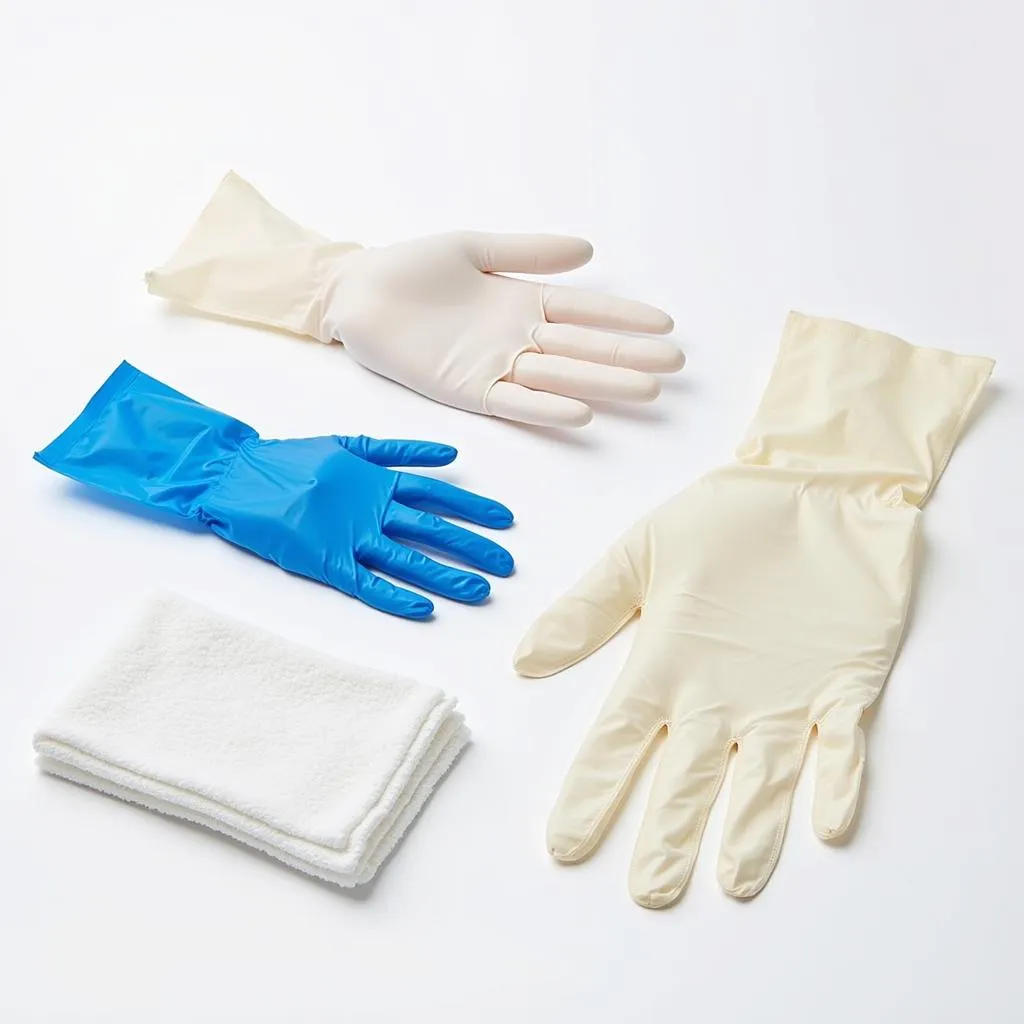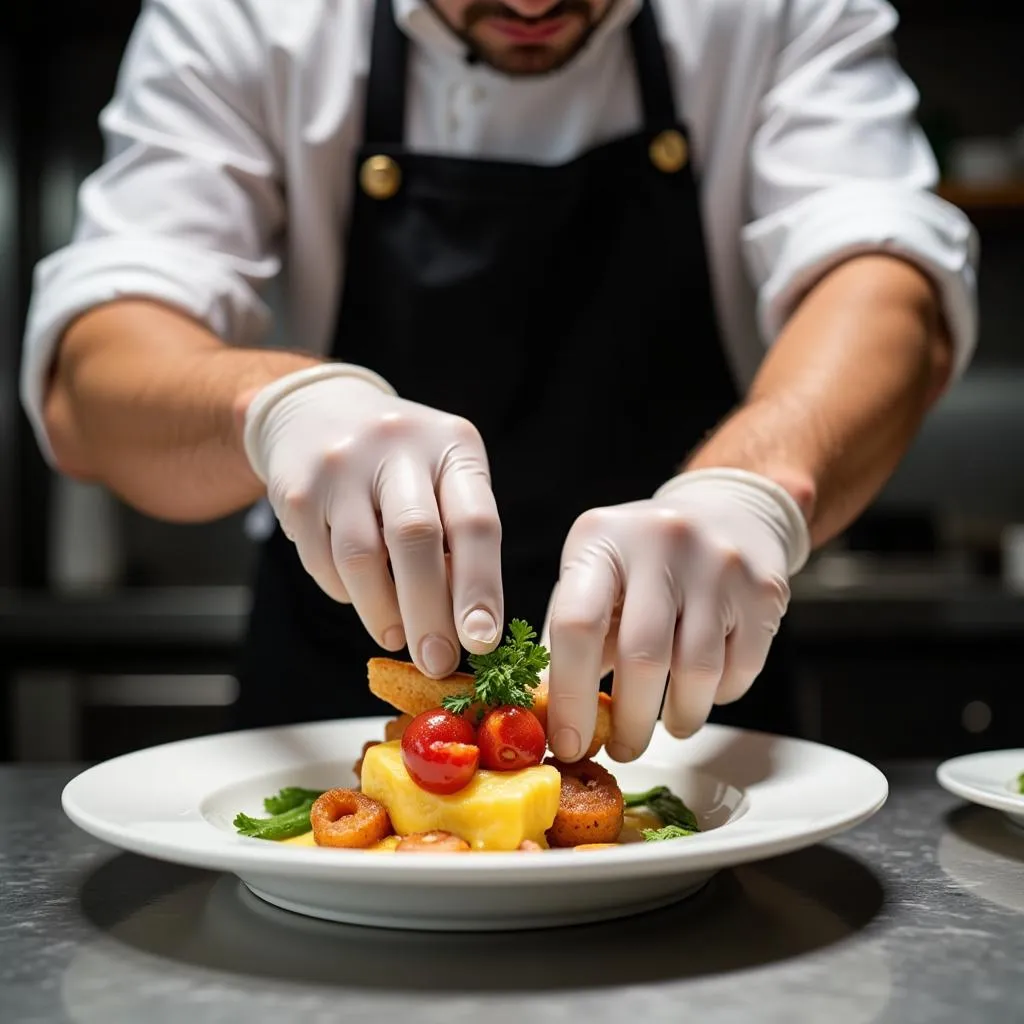Disposable Gloves For Food Handling are a must-have in any kitchen, whether you’re a seasoned chef or a home cook. They’re a simple yet effective way to ensure food safety and hygiene, protecting both you and those who enjoy your culinary creations.
 Different types of food handling gloves
Different types of food handling gloves
Why Use Disposable Gloves for Food Handling?
Using disposable gloves creates a barrier between your hands and food, preventing the spread of bacteria and other contaminants. Let’s dive into the compelling reasons why these gloves are indispensable:
- Preventing Cross-Contamination: Imagine preparing raw chicken and then, without washing your hands, assembling a salad. Sounds risky, right? Disposable gloves eliminate this risk by preventing the transfer of bacteria between different foods.
- Maintaining Hygiene: Our hands are home to a surprising amount of bacteria. Even with thorough handwashing, there’s always a chance of contamination. Disposable gloves provide an extra layer of protection, ensuring food remains hygienic and safe for consumption.
- Protecting Your Skin: Frequent handwashing, while essential, can take a toll on your skin, leading to dryness and irritation. Disposable gloves act as a shield, protecting your hands from harsh cleaning agents and prolonged exposure to water.
Choosing the Right Gloves: A Guide to Materials
Not all disposable gloves are created equal. Different materials offer varying levels of protection, durability, and comfort. Here’s a breakdown to help you choose the right gloves for your needs:
- Nitrile Gloves: These gloves are known for their superior puncture resistance, chemical resistance, and durability. They’re an excellent choice for handling a wide range of foods, especially those that are greasy or acidic.
- Vinyl Gloves: Vinyl gloves are a more economical option, offering decent protection against contamination. They’re suitable for tasks that involve minimal contact with food, such as serving pre-prepared items.
- Polyethylene Gloves: These gloves are lightweight and economical, making them ideal for short-duration tasks like handling ready-to-eat foods.
 Choosing the right type of disposable glove based on food type
Choosing the right type of disposable glove based on food type
When to Use Disposable Gloves for Food Handling
While common sense plays a role, here’s a clear guideline on when disposable gloves are essential:
- Handling Raw Meat, Poultry, and Seafood: These foods are known to harbor bacteria that can cause foodborne illnesses. Using gloves during preparation minimizes the risk of cross-contamination.
- Working with Allergens: If you’re handling allergenic ingredients like nuts, dairy, or shellfish, wearing gloves prevents cross-contamination and protects individuals with allergies.
- Preparing Ready-to-Eat Foods: Salads, sandwiches, and other ready-to-eat items require an extra layer of hygiene. Gloves ensure these foods remain safe for consumption.
Beyond Food Safety: The Added Benefits
Disposable gloves offer advantages that extend beyond hygiene:
- Enhanced Food Presentation: Wearing gloves while plating and garnishing adds a touch of professionalism and elevates the visual appeal of your dishes.
- Reduced Food Waste: Gloves prevent the transfer of flavors and odors between foods, minimizing the risk of unwanted taste contamination. This helps reduce food waste, as dishes are less likely to be discarded due to off-flavors.
 Chef wearing disposable gloves while plating a dish
Chef wearing disposable gloves while plating a dish
Tips for Using Disposable Gloves Effectively
To maximize the benefits of disposable gloves, keep these tips in mind:
- Choose the Right Size: Gloves that are too tight can restrict movement and tear easily, while loose gloves compromise dexterity and increase the risk of contamination.
- Change Gloves Frequently: Replace gloves every time you switch between tasks, especially after handling raw meat, poultry, or seafood.
- Wash Your Hands After Use: Even with gloves, it’s crucial to wash your hands thoroughly after removing them.
FAQs About Disposable Gloves for Food Handling
Q: Are all disposable gloves food-safe?
A: Look for gloves that are specifically labeled as “food-safe” or “food grade.” These gloves have undergone testing to ensure they’re safe for contact with food.
Q: Can I wash and reuse disposable gloves?
A: Disposable gloves are designed for single use. Washing them compromises their integrity and increases the risk of contamination.
Q: What’s the difference between powdered and powder-free gloves?
A: Powdered gloves are easier to put on and take off, but the powder can sometimes interfere with food preparation. Powder-free gloves eliminate this issue.
Conclusion
Disposable gloves for food handling are an indispensable tool for maintaining a safe and hygienic kitchen. By incorporating them into your culinary routine, you not only safeguard your health but also elevate the quality and presentation of your food. Remember, food safety is a shared responsibility, and every step you take contributes to a healthier and more enjoyable dining experience.
Need help choosing the right disposable gloves for your needs? Contact us at Phone Number: 02437655121, Email: minacones@gmail.com Or visit us at: 3PGH+8R9, ĐT70A, thôn Trung, Bắc Từ Liêm, Hà Nội, Việt Nam. We have a 24/7 customer service team. You can also find more information about our disposable food serving gloves and food handling disposable gloves on our website.